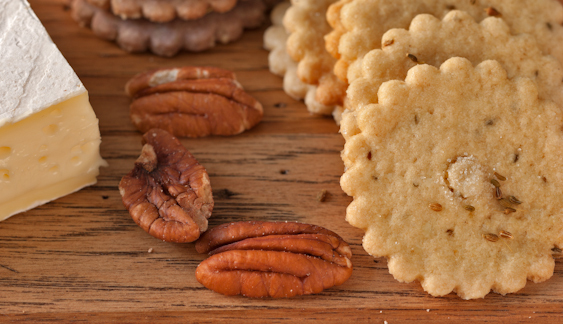Wine Biscuits

introduction
Charleston has always celebrated each season and every event with an extravagant spread of traditional foods, particularly sweets. A look at two cookbooks of the same era, circa 1820, demonstrates as much. While Mary Randolph’s The Virginia Housewife occupies itself with an across-the-board presentation of regional Virginia foods, Sarah Ruttledge’s The Carolina Housewife abbreviate both starter and main course secions, and devotes nearly half of its pages to recipes for desserts!
We were, thus, not surprised to discover that Charlestonians held frequent afternoon wine parties. By frequent we mean daily, and by wine we mean wines of extraordinary quality. The wines called for bright and tart fruits, robust cheeses, and a special pastry called Charleston Wine Tasting Biscuits.
Thus evolved a unique foodway. The biscuits were sturdy and crisp enough to support the burden of cheese, but delicate enough to step out of the way and allow the wines to get up on stage. We imagine these biscuits deftly spiced and infused with enough good wine to present a pleasant frisson of flavor.
And that is precisely what we have: red or white wine biscuits, finely textured with a touch of almond meal, sprinkled throughout with the tiniest trace of anise seeds, and baked crisp. They possess the affable, mild sweetness of a wheatmeal biscuit set against a subtle, lingering vinous finish. Their flavor is enhanced by, and they show themselves dramatically compatible with, any wine. We also like to consume them simply: one after another, back to back, like cookies.
equipment mise en place
For this recipe, you will need a digital kitchen scale, a food processor, a large mixing bowl, a whisk, a rubber spatula, a rolling pin, parchment paper, a few baking sheets, a 2¼-inch round plain or fluted cookie cutter, a toothpick or wooden skewer, and a wire rack.
-
-
2ounces (½ cup) whole blanched almonds
-
1.5to 1.75 ounces (3½ to 4 tablespoons) sugar, depending on your sweetness preference, plus additional for dusting
-
7ounces (1½ cups) Anson Mills Colonial Style Fine Cloth-Bolted Pastry Flour
-
½teaspoon baking powder
-
½teaspoon fine sea salt
-
1teaspoon anise seeds, plus additional for sprinkling
-
⅓cup Cabernet Sauvignon or Zinfandel, or Chardonnay
-
⅓cup almond oil
-
-
Turn the almonds into the food processor and process to a very fine meal, 30 to 45 seconds (fig. 1.1). With the machine running, pour the sugar through the feed tube and process 10 or 15 seconds longer. Transfer the almond-sugar mixture to a large mixing bowl. Add the flour, baking powder, salt, and anise seeds to the bowl and whisk well to combine. Make a well in the center of the flour mixture. Pour the wine and oil into the well (fig. 1.2) and fold the liquid ingredients into the dry with a rubber spatula. The dough will come together very easily.
-
Divide the dough evenly into 2 pieces, about 7 ounces each. On a sheet of parchment paper cut to fit in a baking sheet, roll out one piece of dough to a 1/16-inch thickness (fig. 2.1). (You won’t need flour or a top sheet of parchment to roll it out.) Slide the parchment onto a baking sheet and refrigerate the dough. Roll out the second piece in the same fashion. Refrigerate the dough for 15 to 20 minutes.
-
Adjust an oven rack to the upper-middle position and heat the oven to 325 degrees. Remove one sheet of dough from the refrigerator and slide the parchment with the dough onto the work surface. Using a 2¼-inch round plain or fluted cookie cutter, stamp out as many biscuits as possible. Use a toothpick or wooden skewer to lift out the scraps from between the stamped rounds (fig. 3.1). Ball the scraps up and set them aside. Dust the rounds with sugar and sprinkle lightly with anise seeds (fig. 3.2). Bake the biscuits on the baking sheet until uniformly golden, about 15 minutes. While the first batch is baking, stamp out rounds from the second sheet of dough and combine the scraps with those from the first batch. Roll out the scraps on a third parchment sheet, refrigerate, and then stamp out more biscuits. Bake the second and third baking sheets of biscuits one at a time. Let cool completely on a wire rack. Stored in an airtight container, the biscuits will keep for 4 or 5 days.
-
-
1.1

-
1.2

-
-
-
2.1

-
-
-
3.1

-
3.2

-